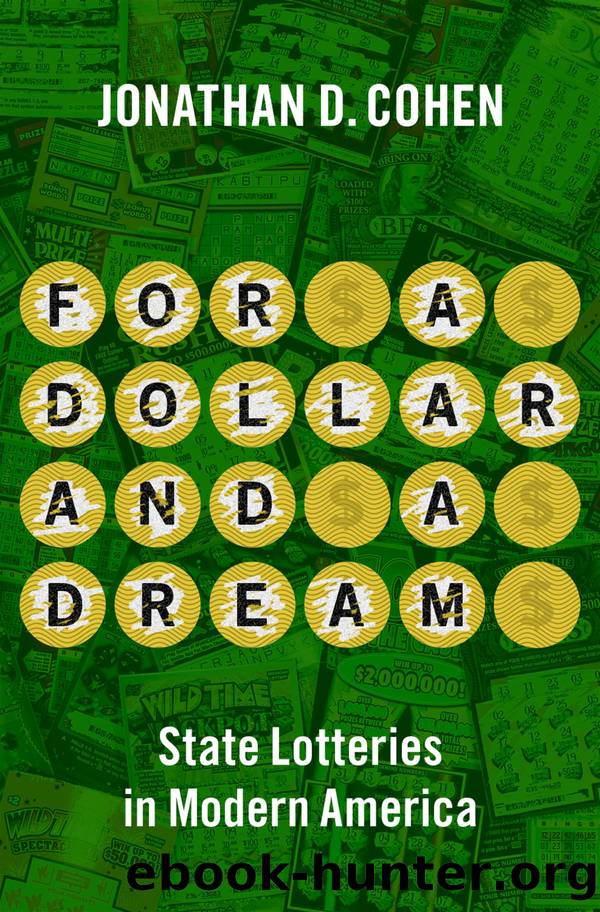For a Dollar and a Dream by Jonathan D. Cohen

Author:Jonathan D. Cohen
Language: eng
Format: epub
Publisher: Oxford University Press
Published: 2022-06-15T00:00:00+00:00
Advertising has always been crucial to the success of lotteries. More so than other forms of gambling, lotteries rely on mass participation, on as many tickets as possible being sold to large numbers of players. In the American colonial period, lotteries were advertised on handbills, on street posters, and in newspapers. Promotional materials detailed all pertinent information: jackpot size, ticket cost, locations to buy tickets, the date of the drawing, and who or what the lottery was raising money for. In some cities, lottery ads were even more ubiquitous than they are today. A New York City grand jury wrote in the early 1830s that âsome of our principal streets are literally disfigured by [lottery] advertisements.â These were no mere informational inducements. In 1833, a Pennsylvania lawmaker described âhand-bills of the most insidious and seductive characterâ thrust into the hands of Philadelphia residents. âPowerfully appealingâ images were used for âdeceiving the credulous and alluring the unwary. A prize is always promised.â11
As states cracked down on lotteries in the nineteenth century, legal and political debates over sweepstakes gambling centered around the question of advertising. By the 1880s, the nationâs lone remaining sweepstakes was the Louisiana State Lottery Company, which was notorious for its reach into states that had barred gambling. With state governments helpless to stop the flood of promotions from Louisiana and from nascent illegal gambling operations, Washington took action. Congress passed a series of laws restricting the interstate transportation of lottery tickets as well as the distribution of gambling promotions through the mail. The lottery ticket restriction was upheld by the Supreme Court in Champion v. Ames (1903), a groundbreaking ruling that affirmed Congressâs ability to regulate interstate commerce.
Seven decades later, these laws presented a serious stumbling block for states seeking to publicize their newly established government-run lotteries. Newspapers were uncertain about what exactly constituted promotional material. Because of the restrictions on the interstate transmission of gambling information, papers could not send lottery news or advertisements to readers across state lines, meaning the New York Times would have to remove lottery ads in order to legally deliver to customers in Connecticut. Shortly after its founding in 1934, the Federal Communications Commissions (FCC) extended the ban on broadcasting lottery information, a policy that the agency decided in 1967 also applied to government-run games. Television and radio stations were prohibited from airing lottery drawings or even showing winning numbers, and ABC and NBC initially refrained from broadcasting any information about the lottery altogether, even in news reports.12 These restrictions severely hampered the games at a vulnerable point in their development. If early lottery winners were unable to attend drawings in person, they found out they had won only when they were contacted directly by lottery representatives or if they called a hotline set up by the lottery that read the winning numbers. Unsurprisingly, prizes frequently went unclaimed. In 1974, the New Jersey Lottery needed to seek special permission from the FCC to broadcast a limited number of radio spots to let residents know about unclaimed prizes.
Download
This site does not store any files on its server. We only index and link to content provided by other sites. Please contact the content providers to delete copyright contents if any and email us, we'll remove relevant links or contents immediately.
| Canada | Caribbean & West Indies |
| Central America | Greenland |
| Mexico | Native American |
| South America | United States |
Cat's cradle by Kurt Vonnegut(15251)
Pimp by Iceberg Slim(14433)
4 3 2 1: A Novel by Paul Auster(12328)
Underground: A Human History of the Worlds Beneath Our Feet by Will Hunt(12049)
The Radium Girls by Kate Moore(11967)
Wiseguy by Nicholas Pileggi(5704)
The Fire Next Time by James Baldwin(5379)
Perfect Rhythm by Jae(5354)
American History Stories, Volume III (Yesterday's Classics) by Pratt Mara L(5274)
Paper Towns by Green John(5136)
Pale Blue Dot by Carl Sagan(4949)
A Higher Loyalty: Truth, Lies, and Leadership by James Comey(4903)
The Mayflower and the Pilgrims' New World by Nathaniel Philbrick(4452)
The Doomsday Machine by Daniel Ellsberg(4446)
Killers of the Flower Moon: The Osage Murders and the Birth of the FBI by David Grann(4406)
The Sympathizer by Viet Thanh Nguyen(4336)
Too Much and Not the Mood by Durga Chew-Bose(4297)
The Borden Murders by Sarah Miller(4270)
Sticky Fingers by Joe Hagan(4142)
